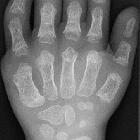Ellis-van-Creveld syndrome

Ellis–van
Creveld syndrome, X-ray left hand with ossification abnormalities os hamatum, cone-shaped epiphyses

Newborn with
short stature. CXR AP and lateral shows the ribs to be short and the thorax to be narrow.The diagnosis was chondroectodermal dysplasia.

Newborn with
short stature. AP radiograph of the hand shows polydactyly with fusion of the fifth and sixth metacarpals. The middle phalanges are short and broad and the distal phalanges are hypoplastic.The diagnosis was chondroectodermal dysplasia.

Chondroectodermal
dysplasia • Ellis-van Creveld syndrome - Ganzer Fall bei Radiopaedia

Chondroectodermal
dysplasia • Ellis-van Creveld syndrome - Ganzer Fall bei Radiopaedia
Chondroectodermal dysplasia, also known as the Ellis-van Creveld syndrome, is a rare type of skeletal dysplasia. It is classified as a type of mesomelic limb shortening .
Clinical spectrum
Clinical features include:
- narrowing of thorax with short ribs
- small and flared ilia
- triradiate acetabula
- cleft lip and / or palate
- epispadias
- cryptorchidism
- polydactyly: tends to be post axial
- limb anomalies
- short limbs: especially forearm and lower leg
- bowing of humerus and femur
- hypoplasia of proximal tibial ossification center
- genu valgum
- short fibula
- carpal fusion
- short and broad middle phalanges
- hypoplastic distal phalanges
- short stature
- sparse, absent, or fine textured hair
- dental anomalies
- peg teeth
- widely spaced teeth
- natal teeth
- delayed teeth
- missing teeth
Pathology
Genetics
It is caused by defects in one of two Ellis van Creveld syndrome genes (EVC1 and EVC2) that are next to each other on chromosome 4p16 . It is thought to carry an autosomal recessive inheritance with variable expression .
Associations
- congenital cardiac anomalies: may be present in up to ~50% of cases
History and etymology
It is named after Richard W B Ellis of Edinburgh and Simon van Creveld of Amsterdam who first described the syndrome in 1940 .
Siehe auch:
- Polydaktylie
- Rhizomelie
- Herzfehler
- Kryptorchismus
- Skelettdysplasie
- Mesomelie
- epispadias
- Kurzripp-Polydaktylie-Syndrome
- left lip and / or palate
und weiter:

 Assoziationen und Differentialdiagnosen zu chondroectodermal dysplasia:
Assoziationen und Differentialdiagnosen zu chondroectodermal dysplasia:







